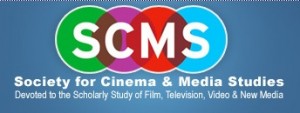Report from SCMS: Thursday
In yesterday’s inaugural conference report, Derek Kompare described his ambivalence about existing academic conference structures, especially when there is not an “active online backchannel” perpetuating and extending some of the conversations beyond the walls of the seminar room. Derek maps this observation onto some of the ongoing conversations we have been having for some time about the “future” of academic conferences, surmising correctly that what we are really talking about is our present moment. In a similar vein, we have been discussing for some time similar questions about the future of academic publishing, in particular about the place of traditional scholarly forms–the monograph, the academic journal–in the age of blogs, Twitter, and YouTube.
These questions were fruitfully addressed in Jennifer Porst and John Bridge’s panel, “From Paper to Blog: The Past, Present, and Future of Cinema and Media Studies Publishing.” The panel seemed especially productive because it seemed to take for granted the assumption that blogs and other online forms are already crucial forms through which scholarly ideas are shared and because of the focus on how newer publication forms might help us to reinvent scholarly publishing in potentially powerful ways. Jason Mittell, reflecting on some of his recent scholarship on television and narrative complexity, offered some productive questions about whether some of our objects of study–contemporary practices in film, TV, and other media–lend themselves to the format of a book. Given the rapid pace of media change, there is incredible value in engaging with these changes in a short, timely manner. Similarly, Eric Faden provocatively called for “bite-sized scholarship,” essentially asking scholars to think about their research production as “scalable,” as potentially fitting into a variety of media forms.
The ongoing debates about new textual models and modes of circulation seemed to inform all of the panels I attended on Thursday. One morning panel looked at the particular challenges raised by adapting comic books into films. Bob Rehak’s paper traced some of the reasons that the adaptation of Alan Moore’s The Watchmen was a “failed experiment,” noting not only the challenges of adapting a self-contained graphic novel (rather than the expansive universe of super heroes such as Batman and Spider-Man) but also director Zack Snyder’s status as a “functionary,” whose attempts at extreme fidelity made the film feel as if it was an exercise. Most all of the papers on the comic book adaptation panel were attentive to the role of paratexts in helping to secure the authenticity of a given adaptation.
Similarly, an afternoon panel on “Making the Peripheral Central to Television Studies” focused on the ways in which “ancillary” texts–DVD extras, TV brands, and other material that might previously have been regarded as ephemera–play a crucial role in constructing the meaning of popular culture texts. In particular, Jonathan Gray traced the ways in which DVD extras contribute to the revival of the aura of the text and the rebirth of the author. Behind-the-scenes interviews on the Pushing Daisies DVD helped to illuminate the ways in which we are trained to see TV shows and movies as crafted by a wide range of creative personnel.
Finally, a panel on “Hollywood’s New Lease on Life” helped to illuminate how the “afterlife” of a film text, to use Barbara Klinger’s phrase, shapes the status of a film text. As Klinger was careful to illustrate, there is a long history of recirculating films after their initial theatrical release. Using the example of It’s a Wonderful Life, which became reinvented as a Christmas classic in the 1980s, Klinger showed that film is a “profoundly circulatory medium,” one that depends on and finds meaning in the reiteration of movies in a variety of a formats, a process that may have profound consequences thanks to the intense fascination with 3D exhibition, a point underscored by Kirsten Thompson, who suggested that 3D offers new opportunities to reboot moribund movie franchises. In all cases, the panelists were attentive to what Jon Lewis called “an expansive film culture,” one that is fueled by the new distribution and exhibition formats.
This work on textual circulation serves as an important area of study, not only in terms of understanding industry practices but also how those practices shape the ways in which meanings are produced. In particular, these panels point to the incredible material available to scholars engaged in creating a history of of the media present, while also reminding us of the importance of past precedents and potential future directions for media distribution.




[…] case you missed it elsewhere, I wrote yesterday’s SCMS conference report for Antenna. It’s pretty much impossible to summarize my reactions to four different panels […]